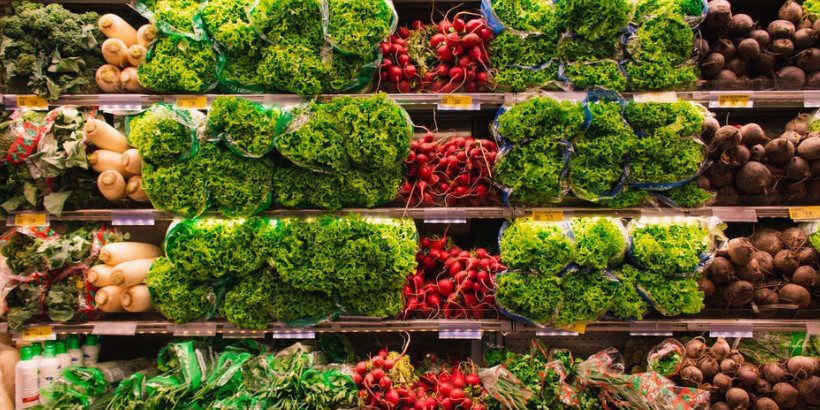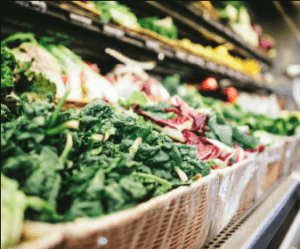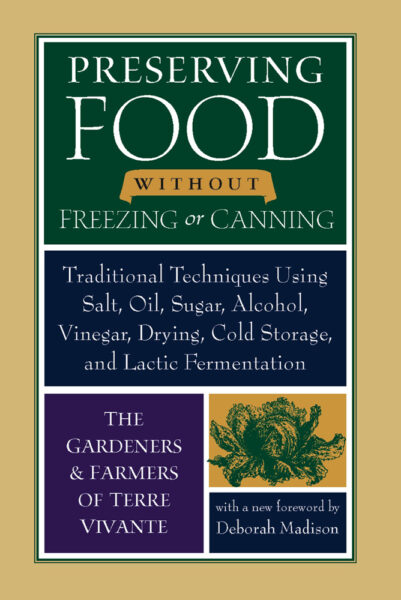A Shopping List for Trying Times: How to Stock Up

There’s been a lot of talk about stocking your fridge and pantry, but what exactly does that mean? What foods store well? What foods provide the most nutritional value? How much toilet paper do you really need? In his lifetime, Matthew Stein wrote extensively about being prepared for the worst, including how to properly stock your pantry for times of trouble. To make your next trip to the grocery store as stress-free as possible, read this shopping list and guide for answers to all your pantry-prepping questions.
The following is an excerpt from When Disaster Strikes by Matthew Stein. It has been adapted for the web.
If you are planning to store food, water, and other items to supply your household for significant periods of time (more than one month), the packaging, preservation, and nutritive quality of your food stores will be vitally important. You can purchase specialty prepackaged bulk foods from preparedness/ survival suppliers (see appendix 2), or package your own foods. If you have more time than money, packaging your own supplies will be far less expensive than the prepackaged types and gives you the best chance for ensuring that your stored food is of the quality and variety that you will want to eat.
 You will probably want to store a significant variety of foods preserved by a variety of methods. Traditional high-heat canning processes destroy a significant portion of the food’s nutritive value, but low-heat dehydration results in a loss of only about 10 percent. Many canned foods do have the advantage of providing syrups or juices, which can be a significant source of water if you are experiencing scarcity. If you have access to a source of water, however, it makes better sense to use dehydrated foods. A pound of dry grains or beans will contain many times the calories of a typical pound of canned foods. Each pound of dehydrated fruits or vegetables is equivalent to 10 to 12 pounds of fresh, canned, or frozen produce, and a pound of dry meat is equal to about 3 to 4 pounds of fresh meat.
You will probably want to store a significant variety of foods preserved by a variety of methods. Traditional high-heat canning processes destroy a significant portion of the food’s nutritive value, but low-heat dehydration results in a loss of only about 10 percent. Many canned foods do have the advantage of providing syrups or juices, which can be a significant source of water if you are experiencing scarcity. If you have access to a source of water, however, it makes better sense to use dehydrated foods. A pound of dry grains or beans will contain many times the calories of a typical pound of canned foods. Each pound of dehydrated fruits or vegetables is equivalent to 10 to 12 pounds of fresh, canned, or frozen produce, and a pound of dry meat is equal to about 3 to 4 pounds of fresh meat.
Stored whole grains may be sprouted to give you the nutritive value of fresh “live” food. Most whole grains and beans can be sprouted. The sprouting process converts proteins in the seeds into different essential amino acids and dramatically increases their vitamin content. For example, sprouted soybeans have 700 percent more vitamin C than the dry beans, though they have a lower caloric content. Vitamin C is a natural detoxifier, destroying damaging toxins in the body. It is essential for helping the body maintain an effective immune system and for preventing deficiency conditions, such as scurvy. However, minerals, protein, and caloric content are not improved by sprouting.
The downside to whole grains is that unless they are kept cool, they contain oils that can go rancid, thereby ruining them for consumption. A useful fact to remember is that most foods retain useful nutritive value long after they have lost their aesthetic appeal. However, foods that smell rotten, rancid, or moldy should be thrown out. Mold may be cut off the outside of cheese, apples, and meats, but moldy grain, other fruits, fats, and vegetables should be thrown out. Most molds give off aflatoxins, which are highly toxic poisons, so your living area and foods should be kept as mold free as possible.
Whole grains last much longer than grains ground into flour, because finely ground particles have far more surface area for oxidation (degradation). A grain mill, preferably hand-cranked or combination hand-and- electric powered, is useful for turning your stored grain into flour as it is required. Most long-term storage programs stress wheat storage, because properly stored wheat has an indefinite shelf life. Some wheat discovered in the pyramids was found to be viable after thousands of years. Brown rice, on the other hand, has a typical shelf life of six months to one year, which may be extended to two to three years when packaged with nitrogen or CO2 in properly sealed containers.
Basic Supplies
Here is a checklist of supplies to pick up for stored goods to weather longer term disruptions:
- Water, stored supplies, and water-purification materials. Water is the most important commodity. You can live for a long time without food, but when physically active during hot weather, you may survive only three or four days without water.
- Wheat and other grains, flours, and beans. These are the easiest bulk materials to store for calorie, shelf life, and nutritive value.
- Grain grinder. Buy a quality grinder for grinding grains into flour. You should have a hand-cranked or combination hand-and-power unit that works without power, but an electric grinder is much easier if you use it a lot. It is best to have one electric-powered grain mill and one that operates by hand.
- Cooking catalysts and seasonings. Includes oils, shortenings, salt, leavenings, herbs, and spices. Herbs and spices will
 provide essential phytonutrients and add much needed variety to the usual monotony of stored grain and beans.
provide essential phytonutrients and add much needed variety to the usual monotony of stored grain and beans. - Powdered milk, dairy products, and eggs. These are good for nutritive value and variety in cooking options. These items should be professionally packaged by a reputable food-storage company, since without proper oxygen- reduced packaging, their shelf life will be drastically reduced.
- Sprouting seeds and supplies. With a couple of jars, some nylon stockings, and a variety of seeds, you can eat garden-fresh live foods for pennies a day. I suggest alfalfa seeds, any whole grains, mung beans, soybeans, lentils, and cabbage, radish, and broccoli seeds. See table 3-3 for detailed sprouting instructions.
- Sweeteners. Honey, sugar, and maple syrup are not essential, but may help sweeten an otherwise bitter experience. Honey has the advantage of being a natural topical antibiotic. It has been used for centuries on the battlefield for helping wounds to heal, and will not spoil (to reliquefy crystallized honey, open cap and heat the honey container, using caution if it’s plastic, in simmering or lightly boiling water).
- Canned and dried fruits, vegetables, and soups. Store a variety of your family’s favorites.
- Canned, dried, or frozen meats and fish. Store these if you will use them.
- Dietary supplements. Vitamins and minerals supplement the limited nutritional value of stored foods. I suggest using quality supplements manufactured from live foods wherever possible (check your local health food store).
- Medicines and first-aid kits.
- Pet food and personal items. Don’t forget the things in life that help you stay happy and centered. A couple of decks of cards and a copy of Hoyle’s book of card games can break the tension and generate a lot of laughs when times are tough. Don’t forget the favorite board games and a stack of poker chips too!
- Open-pollinated seeds for gardening. I recommend that you store a variety of seeds for gardening. Use open-pollinated seeds, not hybrids, so you can save seeds from your garden for future needs, if necessary. Do not eat seeds for planting. If they are dyed a bright color, they may be poisonous. Also, they will provide a hundred times more nutrition after the harvest than if eaten first.
- Pleasure foods, including snacks, treats, sweets, and beverages. These may not have much nutritive value, but they are great for lifting morale or giving yourself a little reward.
Recommended Reads
Recent Articles
Oh, honeysuckle…how we love thee. If only there was a way to capture the sweet essence of this plant so we could enjoy it more than just in passing. Luckily, foraging and some preparation can help make that happen! Here’s a springtime recipe that tastes exactly like honeysuckle smells. The following excerpt is from Forage,…
Read MoreIntroducing…your new favorite brunch dish! This whole broccoli frittata is packed with fresh, wildcrafted flavors that are bound to help you start your day off on the right foot. The following is an excerpt from The Forager Chef’s Book of Flora by Alan Bergo. It has been adapted for the web. RECIPE: Whole Broccoli Frittata…
Read MoreWondering where to forage for greens this spring? Look no further than hedges, which serve as natural havens for wild greens and herbs! The following is an excerpt from Hedgelands by Christopher Hart. It has been adapted for the web. Food from Hedges: Salads and Greens Let’s start by looking at all the wild foods…
Read MoreThere’s a whole new world out there when it comes to koji. It doesn’t matter if you’re making bread, cheese, or ice cream, koji helps you pump up the flavor! Growing Koji in Your Own Kitchen Koji, the microbe behind the delicious, umami flavors of soy sauce, miso, fermented bean sauce, and so many of…
Read MoreWhether you’re looking to replace your end-of-the-day cocktail, relax before bed, or want something new to add to your tea, this non-alcoholic mocktail syrup base will do the trick. Delicious and all-natural, take a sip of this nightcap mocktail and feel your troubles melt away. The following is an excerpt from Herbal Formularies for Health…
Read More









